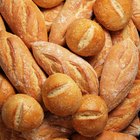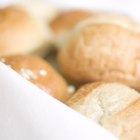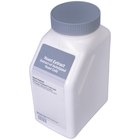
For the casual baker, bread doesn't require a whole lot of thought. If you dump the right ingredients into your bread machine in the right order and in the right quantities, what comes out of the machine a couple of hours later will be a serviceable -- if undistinguished -- loaf of bread. For bakers who want to make outstanding bread, it's a little more complicated. Understanding yeast and fermentation is mandatory, and a few simple tricks like the "finger test" can help a lot.
Yeast Bread Basics
Baking bread is simple in theory, but mastering its complexities can take years. That's because the yeasts and bacteria that give bread its rise and its flavor are living organisms, and are sensitive to temperature, humidity and a wide range of other factors you might not be aware of. Bread machines address this by providing a closed environment with controlled, predictable levels of temperature and humidity. When you're baking bread on your own, you'll have to learn how to judge the dough's fermentation for yourself.
Fermentation
Fermentation is the name bakers and brewers give to the effect of yeasts. Those microscopic organisms digest the natural sugars found in the flour, as well as any additional sweeteners you've put in the bread. As byproducts, they produce alcohol and carbon dioxide. Brewers maximize alcohol production, keeping enough carbon dioxide to give the beer its fizz. Bakers maximize carbon dioxide, which helps the dough rise, but minimize alcohol production. In bread dough, alcohol gives the bread sour "off" flavors and affects the development of the dough's gluten. Whether your favorite bread rises quickly in a warm place, or slowly in a cool place, the baker's "finger test" will tell you when it's fermented enough.
The Finger Test
Most recipes advise letting the bread ferment for a specified time, or until it doubles in bulk. That's a pretty vague guideline. A surer test is to press two fingers into the dough. If it's elastic enough that the mark of your fingers disappears, it hasn't fermented long enough. If your fingers leave a hole that stays unchanged, or if the dough sighs and collapses, you've left it too long. Ideally the mark of your fingers remains in the dough, but springs back partially. It's hard to visualize from a written description, but over time you'll come to recognize the different stages.
What it Means
When you mix your liquids and flour to make the dough, proteins in the flour form long, stretchy strands called gluten. Those gluten strands act like hundreds of thousands of balloons, trapping the carbon dioxide produced by the yeast and causing the dough to rise. If the mark of your fingers disappears, that means the gluten strands are still strong and elastic, and have more stretch left in them. If the dough is soft and retains the mark of your fingers, that means the gluten strands are stretched to their limit. At that point, when you punch down the bread and knead it, you're compressing the gluten strands and making them springy again. When the bread rises once more, the newly strengthened gluten strands will hold it into its final shape.
Related Articles

What Happens if You Leave Bread Dough ...

Can You Proof Yeast in Warm Milk?

Does Yeast Cause Holes in Bread?

Why Does Bread Drop in the Middle When ...

Can You Refrigerate Homemade Yeast ...

How to Freeze Brioche

How to Make Bread With Ancient Grains

When Does Dry Yeast Expire?

Can Yeast Bread Dough Be Frozen Before ...

How to Soften Bread in the Microwave
Can You Refrigerate Homemade Yeast ...
How Long to Knead Bread Dough by Hand?

How to Make Bread Chewy
How to Make Bread That Does Not Crumble ...

Why Bread Dough Does Not Rise

How to Make Bread Tender

How to Grow Bread Yeast

Using Vinegar in Baking

Does Bread Expire?

What Happens if the Yeast Dies Before ...
References
- On Food and Cooking: The Science and Lore of the Kitchen; Harold McGee
- The Bread Baker's Apprentice: Mastering the Art of Extraordinary Bread; Peter Reinhart
- Red Star Yeast: Rising & Ripe Test (First Rise)
Writer Bio
Fred Decker is a trained chef and prolific freelance writer. In previous careers, he sold insurance and mutual funds, and was a longtime retailer. He was educated at Memorial University of Newfoundland and the Northern Alberta Institute of Technology. His articles have appeared on numerous home and garden sites including GoneOutdoors, TheNest and eHow.
Photo Credits
Jupiterimages/Photos.com/Getty Images